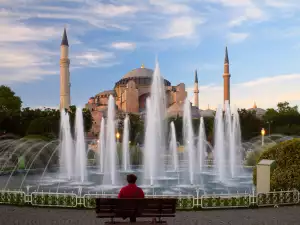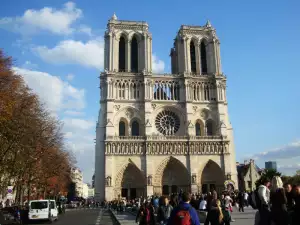The most beautiful cathedrals in the world
Churches, cathedrals and churches are important not only for religious but also for passersby. Even those who are not believers are experiencing these sacred places in their own way.Cathedral Las Lajas, Colombia
Construction of the cathedral Las Lajas takes place of another temple of the twentieth century that began in 1916 and continues to 1949 and is associated with the construction and beautiful legend. An Indian woman named Mary Mueses wore on her back her deaf-mute daughter Rosa, which suddenly spoke and told her mother to stay in a nearby cave. There Rosa painted on the wall of the cave, Mary and Jesus. In this place now stands the Temple and nobody knows how far is the truth and the legend of how it started.

This temple bears the full name "Ehpiatori Temple de la Sagrada Familia". Construction of the cathedral began in 1882 and continues to this day with modern tools such as the building is expected to be completed in 2026. According to the initial project that was designed by the famous Spanish architect Antoni Gaudi, according to the initial project the construction takes more than 40 years. When asked why so much time was needed, he replied: "My client was in no hurry”.
Cathedral of Vasili Blajeni, Russia
Cathedral of Vasili Blajeni is located on the Red Square. It was built by Ivan the Terrible in 1561 and was named after the hermit “Vasili Blajeni”, who is buried there. Despite repeated intentions to be destroyed, it continues to exist. The story goes that the architect, who built the "Vasili Blajeni", was blinded by the king, so he could not build another temple so beautiful.
Temple Hagia Sofia, Turkey
Originally Hagia Sofia is a Christian church. After the capture of Istanbul by the Turks, it was converted into a mosque. Currently, Hagia Sofia is a museum. Construction of the church began in 537, during the time of Byzantine Emperor Julian.

Jubilee, Italy
Some churches are symbols of modern architecture, as the church that Richard Meier built in Rome and not particularly modest proclaims it the "Millennium Project". Sloping arches symbolize the Trinity and a mirror surface where the water remains to remind of the christening.
Crystal Cathedral, California, and USA
This project is a Protestant cathedral of Philip Johnson. It includes 10 thousand square glasses. There can fit 3000 people, and at one end of the hall is one of the largest organs in the world. Technology and facilities have left in this church very little of the traditional details.
Hallgrímskirkja, Iceland
This church has a difficult name to pronounce and was built in the center of the Icelandic capital Reykjavik in 1986 by Gudyon Samyuelson. It gets its name in honor of the poet and the sacred Halgrimur Peterson, who served in it. The appearance of this church reminds geyser as commonly found in Iceland, but it seems as if it was removed from the ancient legend.
Cathedral Notre Dame de Paris, France
The construction of Notre Dame de Paris began in 1163 as decided by the Archbishop Maurice de Sully and lasted 200 years. The world's largest stained glass, depicting scenes from the Bible were there.

Basilica of St. Peter, Vatican City
St. Peter Basilica (Italian: San Pietro in Vaticano), is one of the central sacred places of the Roman Catholic Church. It is the biggest Catholic Church in the world. Its estimated area of 15,000 square meters can hold more than 60,000 people. The first Basilica in this place was built in 324 on the order of the first Christian emperor Constantine and has carried the mortal remains of St. Peter.
